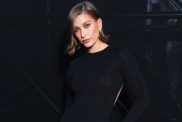Last season at New York Fashion Week, model Ashley Chew designed a bag labeled “Black Models Matter” that quickly became a social media phenomenon. This fall, Zac Posen posed with the same bag on Instagram, crediting Ashley in the caption, ahead of his Fall 2016 show. The message? Black models still matter, in case the rest of the industry isn’t listening.
Fortunately, New York designers are slowly starting to pay attention. Fall 2016 was the most diverse season in recent history. We tallied 120 shows and discovered that 68.1 percent of the model castings were white and 31.9 percent were nonwhite. That’s a slight improvement from Spring 2016 where models of color only accounted for 28.4 percent of castings. That number was even smaller in the two previous seasons. In Fall 2015, nonwhite models topped 24.4 percent and Spring 2015 only saw 20.9 percent nonwhite models.

Yigal Azrouël Fall 2016; Image: Imaxtree
Of course, there’s still progress to be made. Out of 22 models, R13 Denim included just one model of color, which accounts for 4.5 percent of the brand’s lineup. Monse and Yigal Azrouël each hired one model of color out of 20, making their runways 5 percent diverse. A.P.C. hired one nonwhite model out of 12, making it 8 percent racially diverse. And then there’s Rachel Zoe who cast just two models of color out of 20, leading to a 10 percent diversity ranking.

Zac Posen Fall 2016; Image: Imaxtree
On the flip side, several designers embraced diversity in new and profound ways. Posen made a powerful statement at Fashion Week, sending models of color down the runway almost exclusively; 87 percent of his cast included nonwhite models. Brandon Maxwell also stepped up with 53 percent models of color. Designers like Kanye West (Yeezy Season 3), Chromat and Sophie Theallet continued to hire a majority of nonwhite models. Kanye West sent 100 percent models of color down the runway, 85 percent of Chromat models were nonwhite (up from 70 percent last season) and Sophie Theallet cast 54 percent models of color (down 60 percent from last season).

Though progress is slow, there has been a gradual trend toward diversity in New York since our first official report in Spring 2015. Each season is slightly more inclusive than the previous one with New York typically leading the charge. Stay tuned for our full Fall 2016 diversity report at the end of Fashion Month.
With additional reporting from Benedikte Bergevik.







